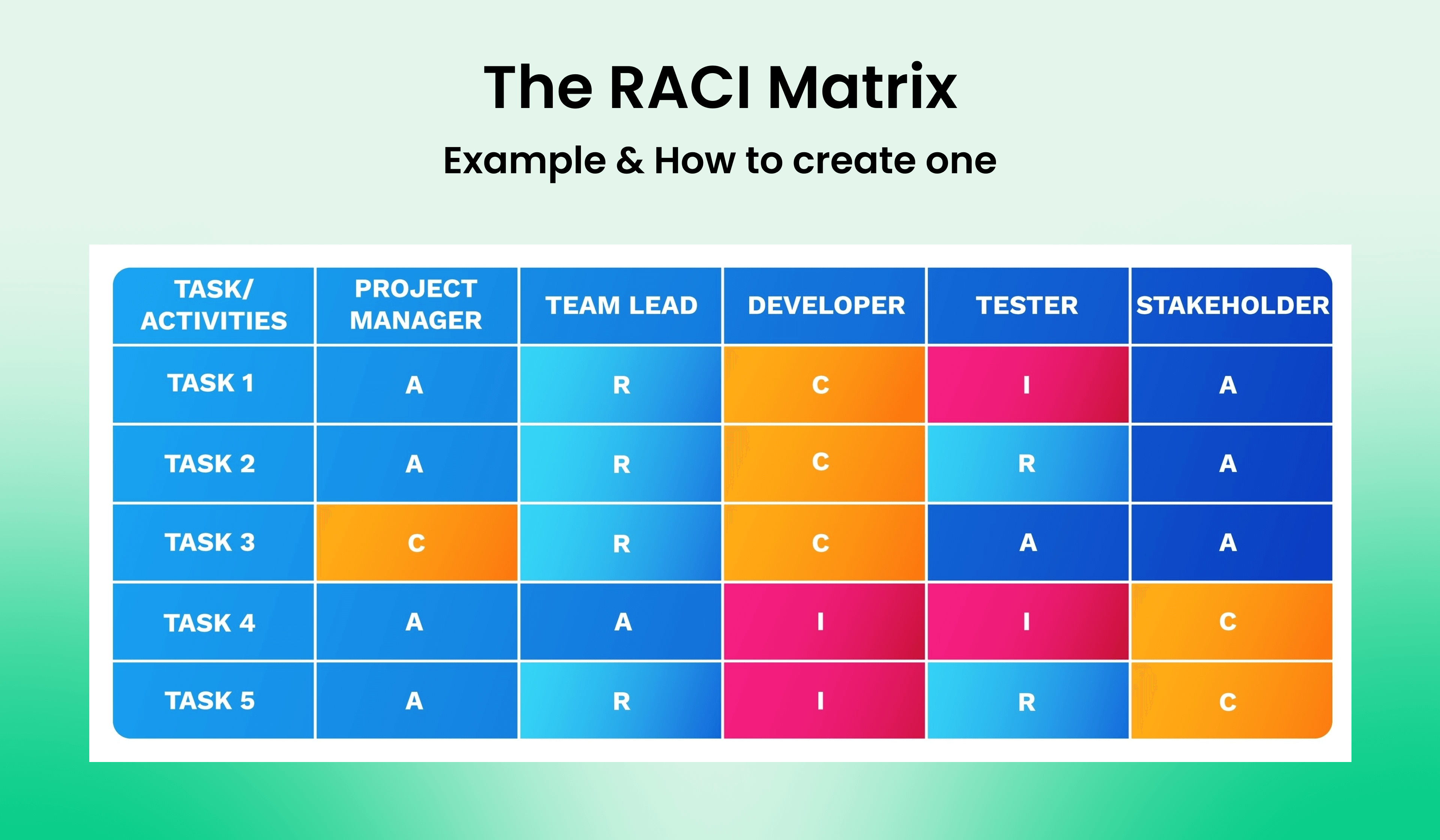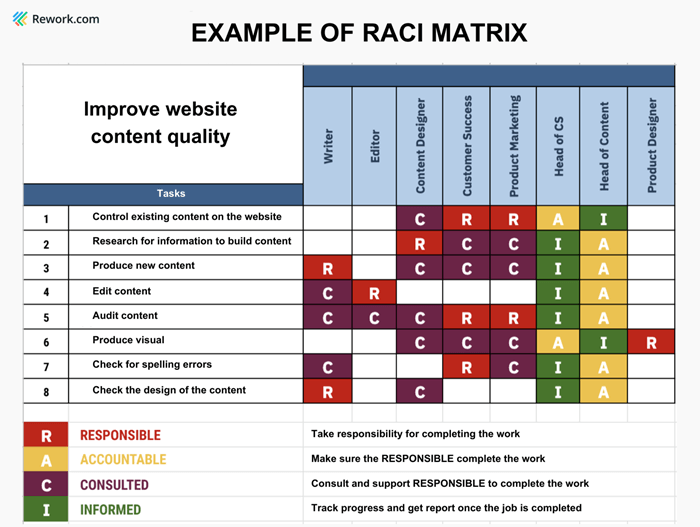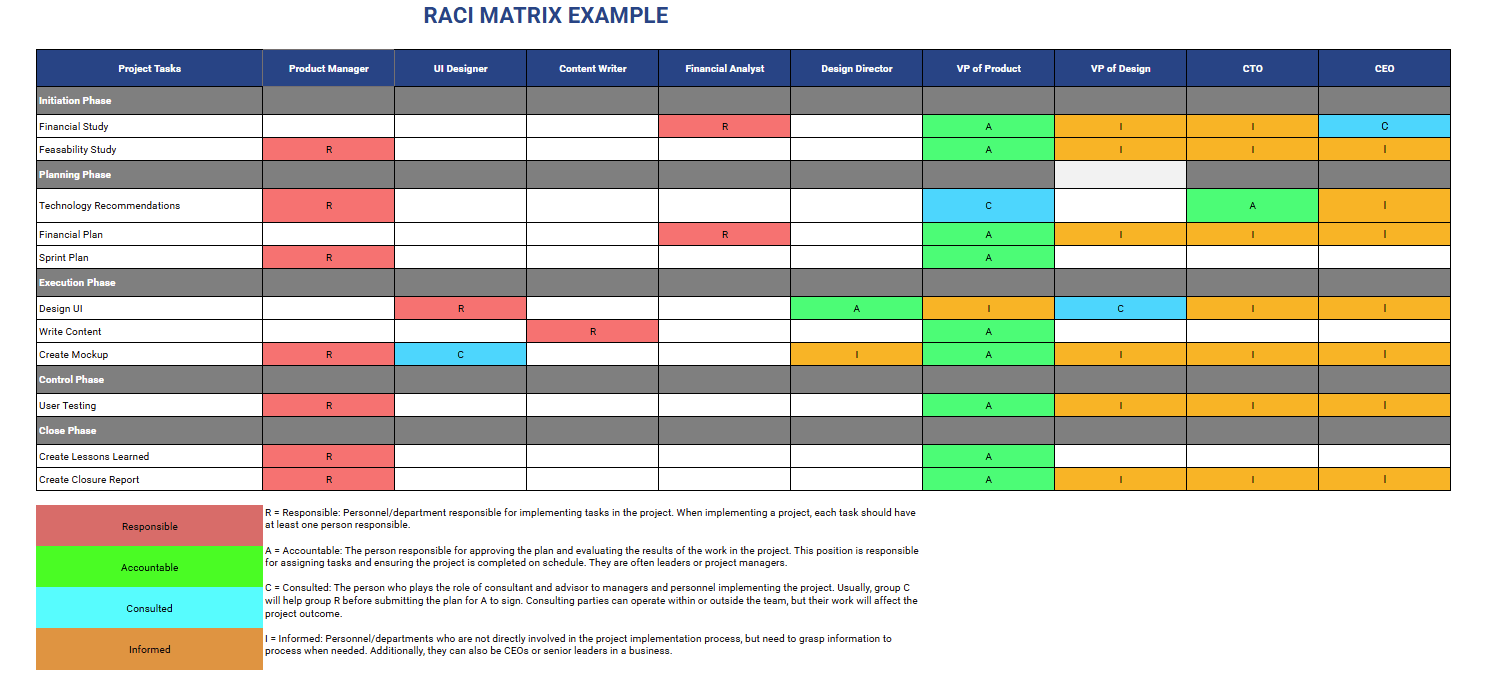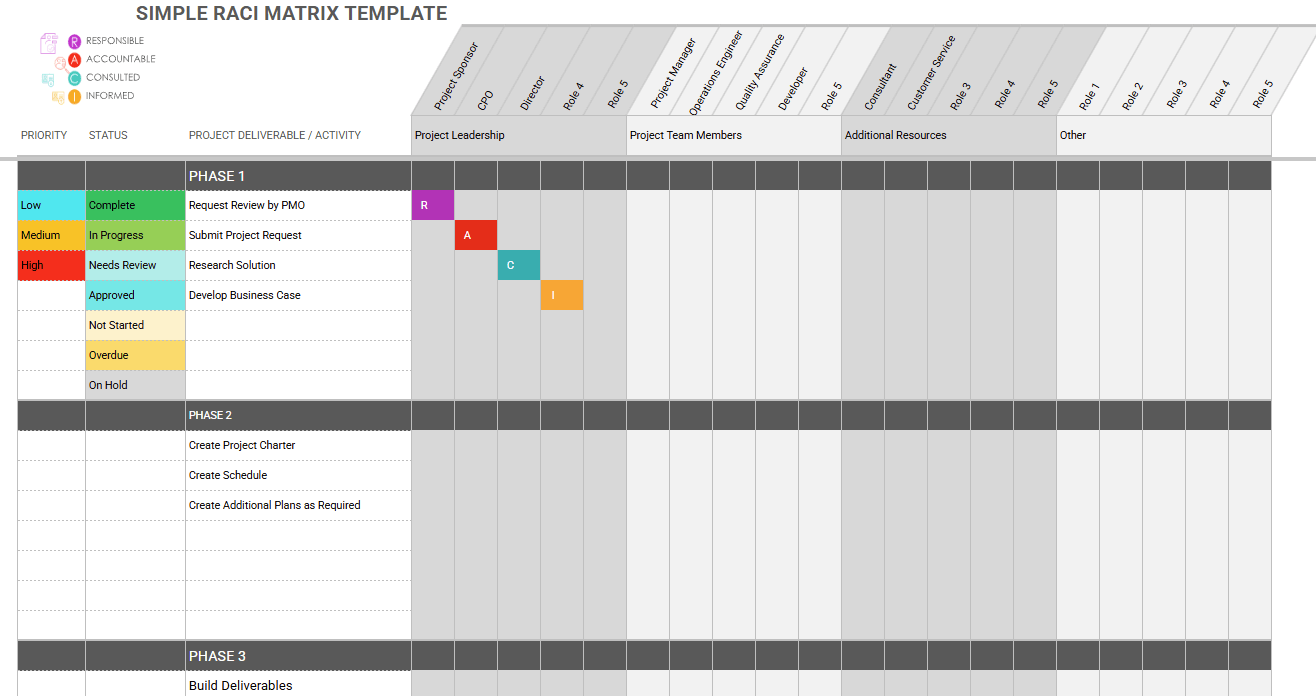Process Management Library
RACI Matrix: What is it and how to create one for your project (without common pitfalls)

Join our webinar: RACI Made Practical: A Role Clarity Framework
RACI matrix is the key to seamless project management, turning chaos into clarity by assigning clear roles to every team member. Let's explore the RACI Matrix in depth in the article below.
What is a RACI matrix?
The RACI matrix (or RACI model, RACI chart) was first used in the 1960s-1970s by project management experts to divide tasks and responsibilities in complex projects. It also improves transparency in operation by clearly defining each team member's role.
Specifically, the RACI Matrix clarifies the roles of different stakeholders into the following categories: Responsible (R), Accountable (A), Consulted (C), and Informed (I).
Responsible (R)
This element designates the individual or department responsible for executing tasks. Each task must have at least one person assigned to ensure it is completed and to avoid delays or incomplete work. When it comes to big tasks with significant resources required, multiple people or teams may be needed to ensure smooth execution.
Accountable (A)
This group holds the authority to make decisions and oversee the tasks within the project. Usually, this person is superior to the responsible team and has a major impact on the project's success or failure. There should only be one person accountable for approvals to avoid confusion and ensure clear decision-making.
Consulted (C)
Consulted individuals or groups are those whose opinions are sought to help ensure a smooth execution. Those responsible for carrying out assigned tasks should seek advice from this team to handle issues quickly and effectively.
Informed (I)
This section involves keeping relevant individuals or departments informed about various aspects of the project, such as progress, costs, resources, and quality. The person (or people) responsible for execution must communicate these updates to the necessary stakeholders.
Example of a RACI matrix
After assigning tasks according to the stakeholders’ skills and working capacity based on the four categories of the RACI chart, the manager will end up with a diagram like this:

When to use the RACI model?
The RACI matrix is well-suited for projects with the following characteristics:
- Complex projects: It helps break down large projects into specific tasks, assigns responsibilities, and simplifies management.
- Projects requiring transparency: The RACI Matrix provides stakeholders with a clear view of the project, making it ideal for those requiring high transparency and accountability.
- Multi-stakeholder projects: For projects involving many individuals or groups, the matrix helps clearly define the roles and responsibilities of each party, avoiding overlaps and conflicts.
- Cross-functional projects: The RACI Matrix identifies the contact points among departments involved in the project, facilitating easier coordination.
Pros and cons of the RACI model
Pros
The RACI matrix is considered a key to project success by improving work performance, enhancing team communication, saving time, and facilitating better delegation.
- Improving work performance: By streamlining responsibilities, the matrix helps achieve high efficiency and ensures no tasks are overlooked.
- Enhancing team communication: Team members communicate better, fostering stronger bonds and working together towards common goals. The model does a great help with avoiding blame-shifting among stakeholders.
- Saving time: It reduces the need for excessive meetings that provide little value or benefits.
- Facilitating delegation and supervision: Organizations can delegate more effectively and monitor work more easily.
Cons
While RACI charts have clear benefits, they can also lead to confusion and delays within projects.
- Role confusion: Multiple roles (especially with too many "C" or "I") can lead to slow decision-making. Besides, the distinction between "Accountable" and "Responsible" can be confusing at first.
- Slow adaptation: The charts can become cumbersome and quickly outdated if project details change, making it difficult to maintain real-time clarity.
How to create a RACI matrix
To create a RACI chart for your projects, follow these four basic steps:
Step 1: Identify tasks and activities
The first step is to identify all tasks and activities that need to be part of the project. This can be done by analyzing the requirements and breaking down large tasks into smaller subtasks. Additionally, using existing project plans is a time-efficient way to capture all necessary tasks.
Step 2: Define roles and participants
Once the tasks and activities are identified, the project leader needs to define the roles and participants involved in the project. This includes the project manager, team leaders, team members, consultants, or any other stakeholders who may influence the project.
Step 3: Assign roles to tasks
After determining the tasks and the roles of each party, the next step is to assign specific roles to each task. For example, if someone is a team leader, determine which specific tasks they will handle. This step can be carried out through meetings or group discussions.
Step 4: Review and adjust
By the end of Step 3, you will have an initial RACI chart. It is crucial to regularly review and assess the chart to ensure consistency and avoid any conflict or overlap. When making adjustments, ensure all members are informed and fully understand their roles, responsibilities, and assigned tasks.
Free download: RACI matrix Excel template
3 templates to help you quickly apply the RACI Matrix in your organization.
The RACI matrix template is structured as a table with the following key components:
- Task/job column: This column lists all the tasks and responsibilities that need to be completed within the project.
- Stakeholder row: This includes the individuals, groups, or organizations involved in executing the tasks or responsibilities.
- RACI role assignment: Roles are assigned as R (Responsible), A (Accountable), C (Consulted), and I (Informed) for each task and the corresponding individual involved.

RACI Matrix template from staff to c-Level

RACI Matrix template with group roles
RACI model common pitfalls (and how to avoid)
When developing your RACI matrix, there are certain rules to resolve conflicts and ambiguities in the plan, including:
- Assign at least one Responsible party to every task.
- Designate a single Accountable person for clear decision-making on each task.
- Ensure that every team member has a role for each task, even if it's just to be Informed.
To avoid common pitfalls in your RACI matrix, review each row and column for consistency and clarity.
If a stakeholder column has:
- Too many R's: If there are too many “Responsible” roles for one person in the matrix, consider whether a stakeholder may have too many tasks assigned.
- No empty cells: You don’t need to fill in every cell of the RACI matrix. Assess whether this individual truly needs to be involved in all tasks. Consider if someone designated as Responsible could be changed to Consulted, or if Consulted roles could be shifted to Informed.
If a task row has:
- Too many R’s: A large number of 'R's attached to a single task may suggest that multiple departments are redundantly involved, leading to inefficiencies. You should reevaluate to ensure responsibilities are appropriately distributed.
- More than one 'A': There must be one and only one “Accountable” in the RACI matrix, representing the individual responsible for the final result. If there are multiple 'A's, it could signal confusion over decision-making authority.
Keep your team aligned and focused
Applying the RACI matrix alone doesn’t guarantee project success; it’s just one of the first steps. However, it is a powerful method to empower your team by clarifying focus areas and enabling leadership within their expertise. Feel free to use our RACI model template and share it with your team. I hope this article helps you stay on track with all of your deliverables!
On this page
- What is a RACI matrix?
- Example of a RACI matrix
- When to use the RACI model?
- Pros and cons of the RACI model
- How to create a RACI matrix
- Step 1: Identify tasks and activities
- Step 2: Define roles and participants
- Step 3: Assign roles to tasks
- Step 4: Review and adjust
- Free download: RACI matrix Excel template
- RACI model common pitfalls (and how to avoid)
- Keep your team aligned and focused